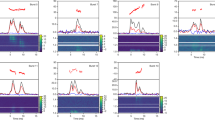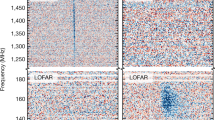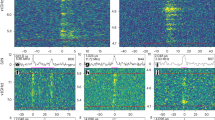Abstract
Fast radio bursts (FRBs) are bright, coherent, short-duration radio transients of as-yet unknown extragalactic origin. FRBs exhibit a variety of spectral, temporal and polarimetric properties that can unveil clues into their emission physics and propagation effects in the local medium. Here, we present the high-time-resolution (down to 1 μs) polarimetric properties of four 1.7 GHz bursts from the repeating FRB 20180916B, which were detected in voltage data during observations with the European Very Long Baseline Interferometry Network. We observe a range of emission timescales that spans three orders of magnitude, with the shortest component width reaching 3–4 μs (below which we are limited by scattering). We demonstrate that all four bursts are highly linearly polarized (≳80%), show no evidence of significant circular polarization (≲15%), and exhibit a constant polarization position angle (PPA) during and between bursts. On short timescales (≲100 μs), however, there appear to be subtle PPA variations (of a few degrees) across the burst profiles. These observational results are most naturally explained in an FRB model in which the emission is magnetospheric in origin, in contrast to models in which the emission originates at larger distances in a relativistic shock.
This is a preview of subscription content, access via your institution
Access options
Access Nature and 54 other Nature Portfolio journals
Get Nature+, our best-value online-access subscription
$29.99 / 30 days
cancel any time
Subscribe to this journal
Receive 12 digital issues and online access to articles
$119.00 per year
only $9.92 per issue
Buy this article
- Purchase on Springer Link
- Instant access to full article PDF
Prices may be subject to local taxes which are calculated during checkout




Similar content being viewed by others
Data availability
The data that support the plots and results in this study are available at https://doi.org/10.5281/zenodo.4350456 or from the corresponding author upon reasonable request.
Code availability
The code used to analyse the data and create the figures in this work can be found at https://github.com/KenzieNimmo/Microsecond_Polarimetry_R3.
References
Petroff, E., Hessels, J. W. T. & Lorimer, D. R. Fast radio bursts. Astron. Astrophys. Rev. 27, 4 (2019).
Cordes, J. M. & Chatterjee, S. Fast radio bursts: an extragalactic enigma. Annu. Rev. Astron. Astrophys. 57, 417–465 (2019).
Farah, W. et al. FRB microstructure revealed by the real-time detection of FRB170827. Mon. Not. R. Astron. Soc. 478, 1209–1217 (2018).
Michilli, D. et al. An extreme magneto-ionic environment associated with the fast radio burst source FRB 121102. Nature 553, 182–185 (2018).
Cho, H. et al. Spectropolarimetric analysis of FRB 181112 at microsecond resolution: implications for fast radio burst emission mechanism. Astrophys. J. Lett. 891, L38 (2020).
Masui, K. et al. Dense magnetized plasma associated with a fast radio burst. Nature 528, 523–525 (2015).
Caleb, M. et al. The SUrvey for Pulsars and Extragalactic Radio Bursts – III. Polarization properties of FRBs 160102 and 151230. Mon. Not. R. Astron. Soc. 478, 2046–2055 (2018).
Day, C. K. et al. High time resolution and polarization properties of ASKAP-localized fast radio bursts. Mon. Not. R. Astron. Soc. 497, 3335–3350 (2020).
Petroff, E. et al. A real-time fast radio burst: polarization detection and multiwavelength follow-up. Mon. Not. R. Astron. Soc. 447, 246–255 (2015).
Ravi, V. et al. The magnetic field and turbulence of the cosmic web measured using a brilliant fast radio burst. Science 354, 1249–1252 (2016).
CHIME/FRB Collaboration et al.CHIME/FRB discovery of eight new repeating fast radio burst sources. Astrophys. J. Lett. 885, L24 (2019).
Luo, R. et al. Diverse polarization angle swings from a repeating fast radio burst source. Nature 586, 693–696 (2020).
Spitler, L. G. et al. Fast radio burst discovered in the Arecibo pulsar ALFA survey. Astrophys. J. 790, 101 (2014).
Spitler, L. G. et al. A repeating fast radio burst. Nature 531, 202–205 (2016).
Kumar, P. et al. Extremely band-limited repetition from a fast radio burst source. Mon. Not. R. Astron. Soc. 500, 2525–2531 (2020).
Gajjar, V. et al. Highest frequency detection of FRB 121102 at 4–8 GHz using the Breakthrough Listen digital backend at the Green Bank Telescope. Astrophys. J. 863, 2 (2018).
Chawla, P. et al. Detection of repeating FRB 180916.J0158+65 down to frequencies of 300 MHz. Astrophys. J. Lett. 896, L41 (2020).
Pleunis, Z. et al. LOFAR detection of 110–188 MHz emission and frequency-dependent activity from FRB 20180916B. Preprint at https://arxiv.org/abs/2012.08372 (2020).
Gruzinov, A. & Levin, Y. Conversion measure of Faraday rotation–conversion with application to fast radio bursts. Astrophys. J. 876, 74 (2019).
Vedantham, H. K. & Ravi, V. Faraday conversion and magneto-ionic variations in fast radio bursts. Mon. Not. R. Astron. Soc. 485, L78–L82 (2019).
Marcote, B. et al. A repeating fast radio burst source localized to a nearby spiral galaxy. Nature 577, 190–194 (2020).
Keimpema, A. et al. The SFXC software correlator for very long baseline interferometry: algorithms and implementation. Exp. Astron. 39, 259–279 (2015).
van Straten, W. et al. PSRCHIVE: Development Library for the Analysis of Pulsar Astronomical Data (2011); https://ascl.net/1105.014
Cordes, J. M., Bhat, N. D. R., Hankins, T. H., McLaughlin, M. A. & Kern, J. The brightest pulses in the Universe: multifrequency observations of the Crab pulsar’s giant pulses. Astrophys. J. 612, 375–388 (2004).
Hessels, J. W. T. et al. FRB 121102 bursts show complex time–frequency structure. Astrophys. J. Lett. 876, L23 (2019).
Sobacchi, E., Lyubarsky, Y., Beloborodov, A. M. & Sironi, L. Self-modulation of fast radio bursts. Mon. Not. R. Astron. Soc. 500, 272–281 (2021).
Cordes, J. M. et al. Lensing of fast radio bursts by plasma structures in host galaxies. Astrophys. J. 842, 35 (2017).
Huppenkothen, D. et al. Quasi-periodic oscillations and broadband variability in short magnetar bursts. Astrophys. J. 768, 87 (2013).
Everett, J. E. & Weisberg, J. M. Emission beam geometry of selected pulsars derived from average pulse polarization data. Astrophys. J. 553, 341–357 (2001).
Lorimer, D. R. & Kramer, M. Handbook of Pulsar Astronomy Vol. 4 (Cambridge Univ. Press, 2005).
Hankins, T. H., Kern, J. S., Weatherall, J. C. & Eilek, J. A. Nanosecond radio bursts from strong plasma turbulence in the Crab pulsar. Nature 422, 141–143 (2003).
Hankins, T. H. & Eilek, J. A. Radio emission signatures in the Crab pulsar. Astrophys. J. 670, 693–701 (2007).
Camilo, F. et al. Transient pulsed radio emission from a magnetar. Nature 442, 892–895 (2006).
Hankins, T. H., Jones, G. & Eilek, J. A. The Crab pulsar at centimeter wavelengths. I. Ensemble characteristics. Astrophys. J. 802, 130 (2015).
Hankins, T. H., Eilek, J. A. & Jones, G. The Crab pulsar at centimeter wavelengths. II. Single pulses. Astrophys. J. 833, 47 (2016).
Dyks, J., Harding, A. K. & Rudak, B. Relativistic effects and polarization in three high-energy pulsar models. Astrophys. J. 606, 1125–1142 (2004).
Lyutikov, M. Fast radio bursts’ emission mechanism: implication from localization. Astrophys. J. Lett. 838, L13 (2017).
Platts, E. et al. A living theory catalogue for fast radio bursts. Phys. Rep. 821, 1–27 (2019).
CHIME/FRB Collaboration.A bright millisecond-duration radio burst from a Galactic magnetar. Nature 587, 54–58 (2020).
Bochenek, C. D. et al. A fast radio burst associated with a Galactic magnetar. Nature 587, 59–62 (2020).
Kirsten, F. et al. Detection of two bright radio bursts from magnetar SGR 1935+2154. Nat. Astron. https://doi.org/10.1038/s41550-020-01246-3 (2020).
Kumar, P., Lu, W. & Bhattacharya, M. Fast radio burst source properties and curvature radiation model. Mon. Not. R. Astron. Soc. 468, 2726–2739 (2017).
Metzger, B. D., Margalit, B. & Sironi, L. Fast radio bursts as synchrotron maser emission from decelerating relativistic blast waves. Mon. Not. R. Astron. Soc. 485, 4091–4106 (2019).
Zhang, B. FRB 121102: a repeatedly combed neutron star by a nearby low-luminosity accreting supermassive black hole. Astrophys. J. Lett. 854, L21 (2018).
Kramer, M., Stappers, B. W., Jessner, A., Lyne, A. G. & Jordan, C. A. Polarized radio emission from a magnetar. Mon. Not. R. Astron. Soc. 377, 107–119 (2007).
Lower, M. E., Shannon, R. M., Johnston, S. & Bailes, M. Spectropolarimetric properties of Swift J1818.0-1607: a 1.4 s radio magnetar. Astrophys. J. Lett. 896, L37 (2020).
Kaspi, V. M. & Beloborodov, A. M. Magnetars. Annu. Rev. Astron. Astrophys. 55, 261–301 (2017).
Lu, W., Kumar, P. & Narayan, R. Fast radio burst source properties from polarization measurements. Mon. Not. R. Astron. Soc. 483, 359–369 (2019).
Beniamini, P., Wadiasingh, Z. & Metzger, B. D. Periodicity in recurrent fast radio bursts and the origin of ultralong period magnetars. Mon. Not. R. Astron. Soc. 496, 3390–3401 (2020).
Cordes, J. M. & Wasserman, I. Supergiant pulses from extragalactic neutron stars. Mon. Not. R. Astron. Soc. 457, 232–257 (2016).
Zanazzi, J. J. & Lai, D. Periodic fast radio bursts with neutron star free precession. Astrophys. J. Lett. 892, L15 (2020).
Levin, Y., Beloborodov, A. M. & Bransgrove, A. Precessing flaring magnetar as a source of repeating FRB 180916.J0158+65. Astrophys. J. Lett. 895, L30 (2020).
CHIME/FRB Collaboration.Periodic activity from a fast radio burst source. Nature 582, 351–355 (2020).
Tendulkar, S. P. et al. The 60-pc environment of FRB 20180916B. Astrophys. J. Lett. 908, L12 (2021).
Ioka, K. & Zhang, B. A binary comb model for periodic fast radio bursts. Astrophys. J. Lett. 893, L26 (2020).
Gourdji, K. et al. A sample of low-energy bursts from FRB 121102. Astrophys. J. Lett. 877, L19 (2019).
Pearlman, A. B. et al. Multiwavelength radio observations of two repeating fast radio burst sources: FRB 121102 and FRB 180916.J0158+65. Astrophys. J. Lett. 905, L27 (2020).
Chatterjee, S. et al. A direct localization of a fast radio burst and its host. Nature 541, 58–61 (2017).
Heintz, K. E. et al. Host Galaxy Properties and Offset Distributions of Fast Radio Bursts: Implications for Their Progenitors. Astrophys. J. 903, 152 (2020).
Hilmarsson, G. H. et al. Rotation measure evolution of the repeating fast radio burst source FRB 121102. Astrophys. J. Lett. 908, L10 (2021).
Marcote, B. et al. The repeating fast radio burst FRB 121102 as seen on milliarcsecond angular scales. Astrophys. J. Lett. 834, L8 (2017).
Tendulkar, S. P. et al. The host galaxy and redshift of the repeating fast radio burst FRB 121102. Astrophys. J. Lett. 834, L7 (2017).
Bassa, C. G. et al. FRB 121102 is coincident with a star-forming region in its host galaxy. Astrophys. J. Lett. 843, L8 (2017).
Rajwade, K. M. et al. Possible periodic activity in the repeating FRB 121102. Mon. Not. R. Astron. Soc. 495, 3551–3558 (2020).
Cruces, M. et al. Repeating behaviour of FRB 121102: periodicity, waiting times, and energy distribution. Mon. Not. R. Astron. Soc. 500, 448–463 (2021).
CHIME/FRB Collaboration. A second source of repeating fast radio bursts. Nature 566, 235–238 (2019).
Macquart, J.-P. et al. A census of baryons in the Universe from localized fast radio bursts. Nature 581, 391–395 (2020).
Rickett, B. J. Amplitude-modulated noise: an empirical model for the radio radiation received from pulsars. Astrophys. J. 197, 185–191 (1975).
Cordes, J. M. Pulsar radiation as polarized shot noise. Astrophys. J. 210, 780–791 (1976).
Huppenkothen, D. et al. Stingray: a modern Python library for spectral timing. Astrophys. J. 881, 39 (2019).
Cenko, S. B. et al. Unveiling the origin of GRB 090709A: lack of periodicity in a reddened cosmological long-duration gamma-ray burst. Astron. J. 140, 224–234 (2010).
McHardy, I. M., Koerding, E., Knigge, C., Uttley, P. & Fender, R. P. Active galactic nuclei as scaled-up Galactic black holes. Nature 444, 730–732 (2006).
Foreman-Mackey, D., Hogg, D. W., Lang, D. & Goodman, J. emcee: the MCMC hammer. Publ. Astron. Soc. Pac. 125, 306 (2013).
van der Klis, M. in Compact Stallar X-ray Sources Vol. 39 (eds Lewin, W. & van der Klis, M.) 39–112. (Cambridge Univ. Press, 2006).
Remillard, R. A., McClintock, J. E., Orosz, J. A. & Levine, A. M. The X-ray outburst of H1743-322 in 2003: high-frequency QPOs with a 3:2 frequency ratio. Astrophys. J. 637, 1002–1009 (2006).
Israel, G. L. et al. The discovery of rapid X-ray oscillations in the tail of the SGR 1806-20 hyperflare. Astrophys. J. Lett. 628, L53–L56 (2005).
Protassov, R., van Dyk, D. A., Connors, A., Kashyap, V. L. & Siemiginowska, A. Statistics, handle with care: detecting multiple model components with the likelihood ratio test. Astrophys. J. 571, 545–559 (2002).
van Straten, W., Manchester, R. N., Johnston, S. & Reynolds, J. E. PSRCHIVE and PSRFITS: definition of the Stokes parameters and instrumental basis conventions. Publ. Astron. Soc. Aust. 27, 104–119 (2010).
Force, M. M., Demorest, P. & Rankin, J. M. Absolute polarization determinations of 33 pulsars using the Green Bank Telescope. Mon. Not. R. Astron. Soc. 453, 4485–4499 (2015).
Gould, D. M. & Lyne, A. G. Multifrequency polarimetry of 300 radio pulsars. Mon. Not. R. Astron. Soc. 301, 235–260 (1998).
Arzoumanian, Z., Nice, D. J., Taylor, J. H. & Thorsett, S. E. Timing Behavior of 96 Radio Pulsars. Astrophys. J. 422, 671–680 (1994).
Acknowledgements
We thank P. Kumar, B. Metzger, L. Sironi, M. Lyutikov, M. van der Klis and P. Uttley for helpful discussions. The EVN is a joint facility of independent European, African, Asian and North American radio astronomy institutes. Scientific results from data presented in this publication are derived from EVN project code EM135. This work was also based on simultaneous EVN and PSRIX data-recording observations with the 100 m telescope of the Max-Planck-Institut für Radioastronomie at Effelsberg, and we thank the local staff for this arrangement. J.W.T.H. acknowledges funding from the Netherlands Organisation for Scientific Research under a Vici grant (‘AstroFlash’, VI.C.192.045). F.K. acknowledges support from the Swedish Research Council. B.M. acknowledges support from the Spanish Ministerio de Economía y Competitividad (MINECO) under grant no. AYA2016-76012-C3-1-P and from the Spanish Ministerio de Ciencia e Innovación under grant nos. PID2019-105510GB-C31 and CEX2019-000918-M of ICCUB (Unidad de Excelencia ‘María de Maeztu’ 2020–2023).
Author information
Authors and Affiliations
Contributions
K.N. discovered the signals, led the data analysis, made the figures, and wrote most of the manuscript. J.W.T.H. guided the work and made important contributions to the writing and interpretation. A.K. performed pre-processing of the EVN voltage data. All other authors contributed significantly to aspects of the data acquisition, analysis strategy or interpretation.
Corresponding author
Ethics declarations
Competing interests
The authors declare no competing interests.
Additional information
Peer review information Nature Astronomy thanks Hyerin Cho and the other, anonymous, reviewer(s) for their contribution to the peer review of this work.
Publisher’s note Springer Nature remains neutral with regard to jurisdictional claims in published maps and institutional affiliations.
Extended data
Extended Data Fig. 1 Autocorrelation functions (ACFs) and power spectra for B4-sb1 and B3.
The temporal profiles of bursts B4-sb1 (top frame) and B3 (bottom frame) are shown in the top left of each frame (panels a and e). The corresponding ACF of these temporal profiles are shown in panels b and f. The corresponding power spectra of the temporal profiles are shown in panels c and g, and the orange line is the power spectrum downsampled in frequency by a factor of 3. Overplotted in pink on the power spectrum is the best fit power law plus white noise component. Panels d and h are the residuals (2 × power spectrum/best fit model).
Extended Data Fig. 2 Before and after calibrating the polarisation data of PSR B2111+46.
The average polarisation profiles (panels b and d) and polarisation position angle (panels a and c) of PSR B2111+46. Black represents the Stokes I profile, red is the unbiased linear polarisation profile (defined in Everett & Weisberg29, and rewritten here in Equation 1), and blue is the circular polarisation (Stokes V) profile. Panels a and b show the polarisation profile and position angle after Faraday-correcting to the true rotation measure79 of PSR B2111+46 (-218.7 rad m−2); here we are not correcting for the instrumental delay between polarisation hands. Panels c and d are Faraday-corrected with the rotation measure determined using the PSRCHIVE tool rmfit, which, in essence, accounts for the instrumental delay. For comparison, we plot the profile and position angle from the literature using more transparent colours80. This illustrates the calibration we applied to the bursts from FRB 20180916B.
Rights and permissions
About this article
Cite this article
Nimmo, K., Hessels, J.W.T., Keimpema, A. et al. Highly polarized microstructure from the repeating FRB 20180916B. Nat Astron 5, 594–603 (2021). https://doi.org/10.1038/s41550-021-01321-3
Received:
Accepted:
Published:
Issue Date:
DOI: https://doi.org/10.1038/s41550-021-01321-3
This article is cited by
-
Detection of ultra-fast radio bursts from FRB 20121102A
Nature Astronomy (2023)
-
Fast radio bursts at the dawn of the 2020s
The Astronomy and Astrophysics Review (2022)
-
Sub-second periodicity in a fast radio burst
Nature (2022)
-
Burst timescales and luminosities as links between young pulsars and fast radio bursts
Nature Astronomy (2022)
-
Chromatic periodic activity down to 120 megahertz in a fast radio burst
Nature (2021)



